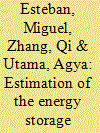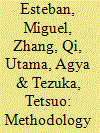| Srl | Item |
| 1 |
ID:
114287


|
|
|
|
|
| Publication |
2012.
|
| Summary/Abstract |
Renewable energy systems are often criticized because of their intermittency and need for substantial amount of backup in terms of other energy sources or storage. The present paper proposes a method to estimate the required amount of storage backup for a mostly solar and wind system that uses also biomass and hydroenergy as minor components of the electricity mix. An hourly simulation was carried out to determine the amount of electricity that could be produced based on the meteorological conditions of year 2001 in Japan, and this was compared with the maximum electricity demands imposed in the system for each month of the year. The system thus proposed has 100% chance of meeting around 40% of the electricity demand between 11:00 and 18:00, and the optimum scenario obtained (a 2:1 mix of solar to wind energy) required around 40 TW of storage to balance the extra electricity demand that occurs during the summer in Japan. It appears unlikely that the batteries in EV in vehicles will be able to meet this storage requirement in the future, though the system is able to adequately meet the electricity demand during the majority of the year, and hence showcases the viability of renewable energy.
|
|
|
|
|
|
|
|
|
|
|
|
|
|
|
|
| 2 |
ID:
103451


|
|
|
|
|
| Publication |
2011.
|
| Summary/Abstract |
For the case of the UK there are currently three ways of obtaining energy from sea areas, namely from wind, tides and waves. A methodology was developed to determine the future size of the offshore renewable industry based on the concept of employment factor, or the number of people required to maintain each unit of electricity production. An assessment was made of the decline in the number of people employed in oil related jobs in the North Sea and the gap that this could create in the UK's economy unless this pool of offshore expertise could find an alternative employment in the renewable sector. The paper will also investigate the effect of gradually transforming the UK's oil and gas sector into offshore renewables. If this was to happen by 2050 the UK offshore renewable industry could produce between 127 and 146 TWh of electricity, equivalent to around 57-66% of the current energy consumption in the country.
|
|
|
|
|
|
|
|
|
|
|
|
|
|
|
|
| 3 |
ID:
101498


|
|
|
|
|
| Publication |
2010.
|
| Summary/Abstract |
The potentially damaging effects of climate change make it imperative to develop zero-carbon energy systems and societies based on renewable energy sources that do not negatively affect the environment. However, these systems are often criticized for their intermittency, and the present paper proposes a method to analyze the true minimum capacity factor that can be expected from such a system based on a historical hourly estimation of the electricity produced by a given solar-wind generating mix. A simulation was carried out to show how much energy could be produced for a sample future group of scenarios encompassing a variety of solar and wind mixes, and the results show that, with a 1:2 mix of solar to wind energy, the system will always operate at least at 10% capacity from 10:00 to 16:00, as calculated using the meteorological conditions of the year 2001. This study also analyzes the land requirements necessary to implement such a solar-wind energy system, highlighting the vast areas that would be necessary to be covered with wind turbines and solar panels if such a system were to supply the majority of the electricity demand in Japan.
|
|
|
|
|
|
|
|
|
|
|
|
|
|
|
|